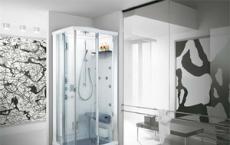Installing the screen on the video bath. Screen of plasterboard with your own hands. Laying of ceramic tiles.
Each shower has its own individual qualities, special appearance, and also convenience. To create an interior design of the room, various practical requirements must be taken into account. First of all, this is due to the unsightly outlines of water pipes and other communications. with your own hands will help get rid of this problem forever.
This fence allows you to hide the unsightly appearance of the swapped space. In addition, the sliding screen is a real element of the overall design of the shower room, so its decorative functions are highly appreciated. To date, there are many variations of products that are created from a variety of materials. Taking into account the diverse execution of design, the room can be transformed beyond recognition.
What are screens for?
Sliding models allow you to maximize the use of the useful area in the shower room. Conventional panels or doors are not very convenient to use, since they take up a lot of space. In order to make the screen under the bath with your own hands, you need to buy an ordinary bathroom with attractive pedestals. The sides of the product should be finished with a special material, which makes it possible for the bathing basin to have a presentable appearance.
Based on the location of communications in the shower room, you need to select this or that model of the screen, the profile of the product, as well as the size of the panels. Otherwise, there is a possibility that the selected frame will not work. Water pipes always unpleasantly conspicuous, so collect the design should only after careful measurements. Otherwise, perhaps, to spoil the overall design of the bathroom, because ugly protrusions do not look very aesthetic.
However, there is another way out - to buy a type of fence, and to make the paneling with your own hands. Usually, when purchasing acrylic products, plumbing is installed with the doors already ready. They allow you to close the premise, taking into account the space saving, i.e. rational use, which eliminates the appearance of large voids as opposed to cast iron or steel products.
In addition, there is another good reason - the possibility of using this space for domestic needs. Often in these niches are stored household items, cleaners or tools. Here you can make wooden or plastic shelves for convenience.
Separately it is worth noting that the swing doors help to get rid of the accumulation of dirt and dust in hard-to-reach places where microorganisms or insects usually develop.
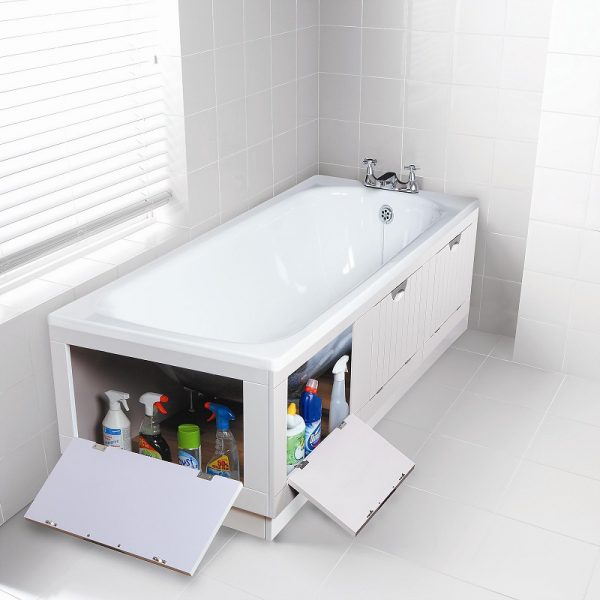
Thus, the panels help to get rid of the various negative consequences caused by unsanitary conditions. The undeniable advantages of these products include their attractive appearance, carefully designed by designers. Modern technologies make it possible not only to put sliding doors under the bathroom, but also to decorate them in a stylish, colorful and unique way. This gives the soul its individuality, which distinguishes it from other premises in the apartment.
What is required?
How to make a screen for a bath, more precisely, from what materials? For the manufacture of sliding panels will need a supporting structure in the form of a profile, as well as the main raw material, from which the composition will be created. In order to determine the choice of material, you need to proceed from the operating conditions of the bathroom, as well as personal preferences. You can carefully think through the image, starting from the tools available.
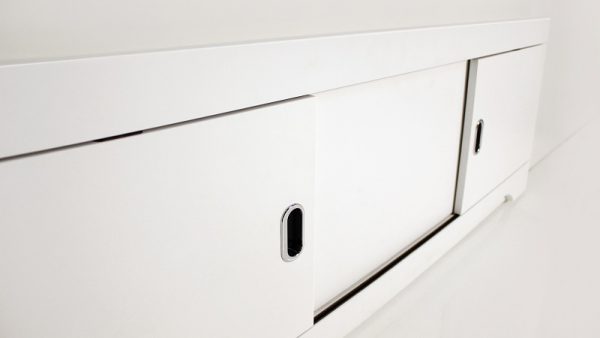
- MDF panels;
- drywall;
- plastic;
- ceramics;
- acrylic.
Separately it is worth noting that sometimes allowed wooden elements, but they must be moisture-resistant, for example, beech or moraine oak. In addition, it is necessary to determine the type of gate valves, i.e. the very design. Screens come with sliding elements, only with one door, tightly closed, and also with a special niche for the feet. All these parameters are very individual and suitable for different shower rooms and directly depend on the owner's taste or financial capabilities.
Self-assembly. Plastic
In order to create a full screen, you need to purchase some tools. Usually, they are supplied with the necessary equipment, as well as related materials. This will allow self-assembly do all the work not only quickly, but also qualitatively. Adaptations should be selected based on the material itself, for example, wood, a saw or jigsaw will be required, and for a ceramic tile a glass cutter.
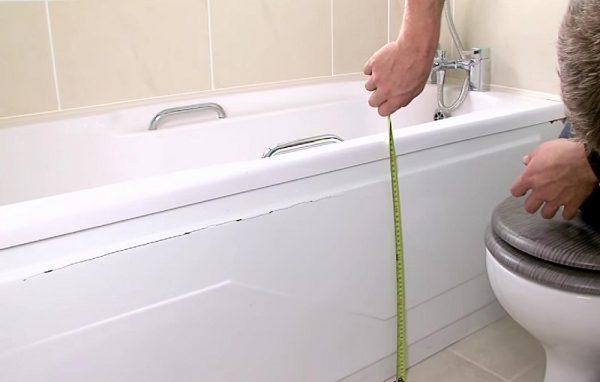
For plastic panels you need:
- Wooden bars to create a structure or supports.
- Liquid nails for fastening various materials.
- Lightweight UD profiles with their attachments.
- Directly plastic blanks.
Separately, it is worth discussing some points, since often the bathrooms in most apartments have a combined view. This means that there is a need to take into account the scheme of the sewage system, i.e. toilet. The placed toilet bowl is an obstacle that must be carefully avoided when installing the screen and its subsequent use. The standard set of tools for installation is:
- building stapler;
- perforator;
- specialized knife for gypsum board;
- screwdriver;
- gon.
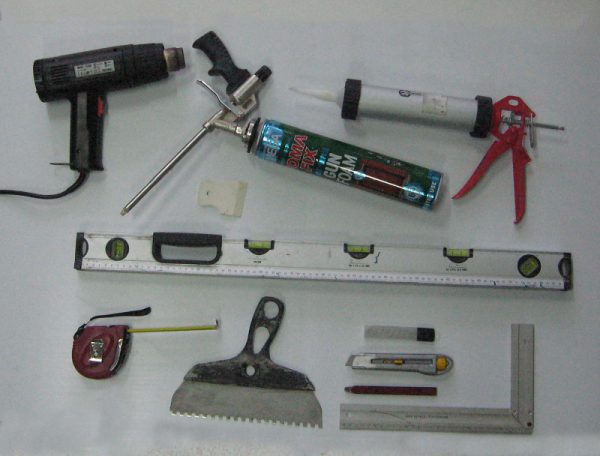
In order to install a screen that will repeat all the shape of the bath you need to measure the line or put markings that repeat all the curves of the bath. After that, using screws the profile of metal or wooden bars is attached to the floor covering. The fixing is made from the inner edge, i.e. The place where the plastic panels will be installed. Using liquid nails, the bathroom and the surrounding surface are not damaged. The timber bars, fixed with screws, will be ideal for the plating selected by the material.
Plastic strips are attached to brusochkam again for liquid nails. From the bottom, a piece of plastic is attached along the top of the profile, as it should leave enough room for a plastic skirting board. For this purpose, self-tapping screws designed for metal products are best suited. In this case, it is necessary to pay attention to the final stage.
This is due to the fact that the last strip is very difficult to attach, since it is necessary to have a certain skill. You should try to combine the first and final parts, and then put it on the side panel. At the same time, the resulting design should have a sufficient density of contact between the parts. This is checked by checking the shrinkage of the grooves.
Tile
The screen under the bath with your own hands can be assembled from various materials. One such is the tile, which is used to finish the sliding panels. It has an external appeal and high performance. In addition, the tile is very common, and in stores it is distinguished by a wide range, so problems with the choice of colors or textures should arise.
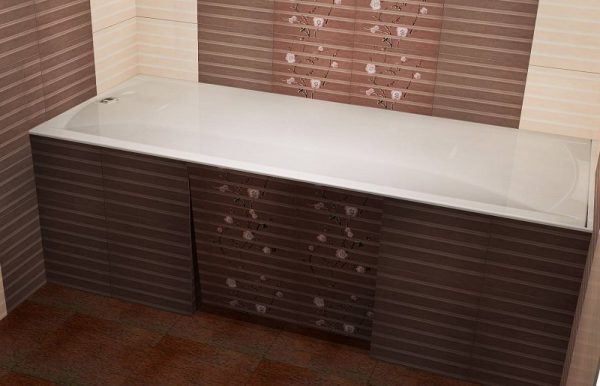
To install it you will need:
- special corners of metal;
- hinges for the door;
- moisture resistant gypsum board;
- various parts for fastening;
- tile;
- bars of wood or metal profiles.
Decoration with ceramic products takes place on the basis of proven technology. To begin with, a strong frame is assembled as the basis of the whole future design. For this, wood or metal is usually used, it is better, of course, the last option. Then the resulting blank is covered with plasterboard panels. On this basis, tiles are applied, which is the face of the screen.
Drywall
Under the installation of the structure of plasterboard will need the same materials and appliances as for tiles. This is explained by the similarity of the process, as they are almost identical and are an integral part of each other. The surface of the screen for the shower room can be pasted with vinyl wallpaper, applied decorative plaster or spread out with tiles. In any case, the fence received will have an attractive appearance.
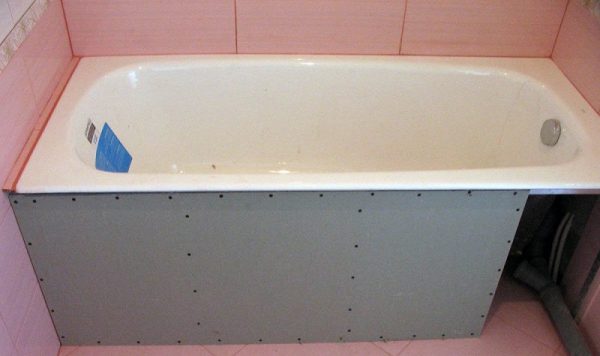
the cloth
One of the most exclusive and rare variants is the tissue septum. It is great for a non-standard way of isolating a premise, however, the practicality of the screen is somewhat lost. This is due, in the first place, to the increased care of the coating, since the tissue requires a little more attention than the rest of the materials. Closure of panels can be carried out independently, using improvised means.
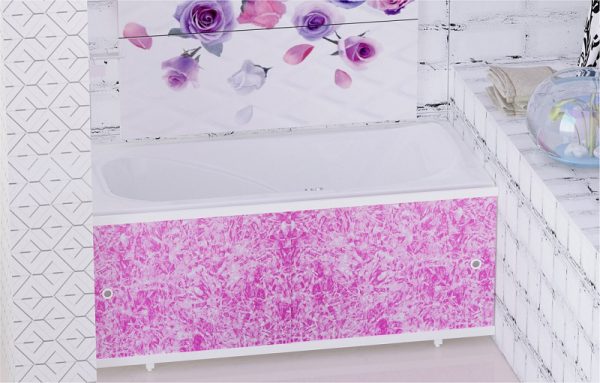
For this variant, the following types of matter are used:

For a screen made of fabric, it is best to prepare a metal frame or wood profiles. On the one hand, these decisions look rather strange, however, they have a practical justification. In addition, the fabric can be combined with various finishing materials or used as curtains. In the form of panels, raw materials are rarely used and are used more as a supplement.
Acrylic
Screens for the bathroom of acrylic are panels of various shapes, shapes and colors. They, as a rule, come complete with acrylic products, they are properly installed and they will last for more than one year. The installation of the frame does not create any difficulties and can be carried out by hand.

MDF
Decorative MDF panels as a sliding screen in the shower room look good. Their installation is carried out by analogy with gypsum plasterboard, however, differs in that it is necessary to add antifouling compounds, but more thoroughly to primer the surface. Separately it is worth noting that the material must be moisture resistant.
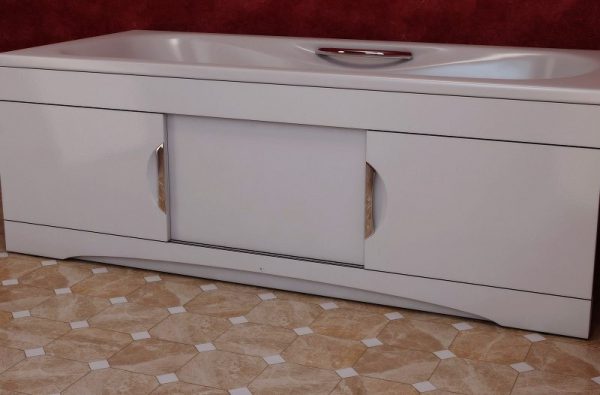
Video instruction
Everyone has his own aesthetic preferences, that's why the variety of interiors of bathrooms is also huge. However, in one question almost all are unanimous: the lower part of the bath from the sides must be closed. To this end, use special screens for the bathroom. They are light, beautiful and easy to install.
Bathroom screens are needed to disguise unaesthetic details, space under the bathroom, and sometimes to get additional space for storing household trivia.
A few decades ago, these functions were performed either by light curtains or by deaf brick walls finished with tiles.
Entering the bathroom, the person sees a bath. If the screen is not installed, then the legs of the bath are visible, the elements of the plumbing system.
They seem ugly, and the entire bathroom looks sloppy. The screen can become an excellent decorative element that will close all unnecessary and help to decorate the room in a unified style.
soviet times it was difficult to find a worthy alternative to the brick walls under the bathroom. Now there are structures of light and beautiful materials, but the brick screens are still installed in some apartments
The design will protect the pipes from moisture and damage, will become an additional locker, where you can store household chemicals, household appliances, sanitary tools and other useful items.
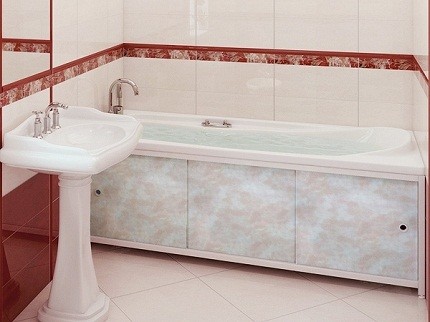
The screens are not only beautiful and practical, they can serve as a reliable barrier that closes access to household chemicals for children and animals
What kinds of screens exist?
Now you can buy screens for baths of any designs and made of any material. Manufacturers decorative panels connect to the design of models of experienced designers.
They develop original designs that can fit in even the most refined interior.
For the manufacture of screens use plastic, metal, MDF, polystyrene, gypsum board, polyvinyl chloride, acrylic. On the surface of the product can be applied patterns, plot pictures (photo printing), decorative elements.
Often there are models of combined materials.
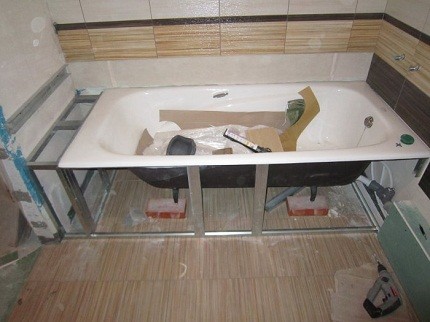
Frameworks for modern screens are made of aluminum, steel or plastic. Often, buyers choose models with aluminum frames, tk. they are durable and affordable
Very original look glass and mirror screens. They are used not only for their intended purpose, but also for modeling the space of bathrooms.
For such panels, use is made not of ordinary glass, but of organic glass. it better resists mechanical damage and shocks.
When choosing a material, one should pay attention to its strength, resistance to moisture and high temperatures. A quality model can last for decades.
Good performance implies a higher price for construction, but this is the case when the investments are justified.
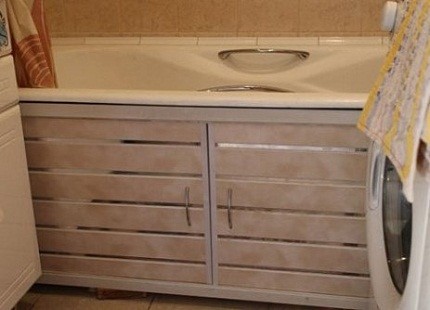
Models in the form of grids are chosen by people who care about good ventilation space under the bathroom. This helps to avoid the appearance of dampness, fungus and unpleasant odor
We choose a convenient construction
Screens consist of a frame (most often aluminum) and panels. They can be deaf or equipped doors for access to communications and objects stored under the bathroom.
There are also models with removable panels, they are usually installed under acrylic bathtubs.
Advantages of blind panels - high aesthetics and durability. A smooth surface can be decorated in any way or left unicolored.
It will look nice regardless of the presence or absence of additional decor. Due to the lack of moving parts, such bath screens last longer.
The drawbacks of deaf stationary structures include the inconveniences that arise in the event of breakdowns in the plumbing system. To access it you will have to shoot the whole panel.
This takes a lot of time, which can cause problems if a leak develops and water collects under the bathroom.
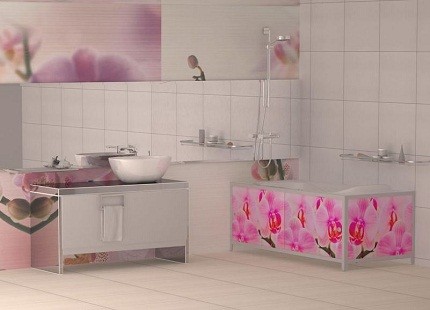
In some interiors, screens perform a style-forming function. A luxurious bright model looks very attractive if the other elements of the design are monochrome or are made in the same style
Constructions with doors are more practical than deaf ones. The doors themselves can be swinging or sliding. Both options have their own merits and demerits.
In most cases, the owners of bathrooms stop on sliding models.
Swing doors are conveniently opened and closed, providing access to the shelves with the necessary trifles.
However, the screen with these doors should not be chosen for a bathroom of a small area. Open, they occupy a useful space and make it difficult to manipulate the elements of the plumbing system.
The doors of the sliding screens under the bath are opened, sliding along the guides. When buying such a system, special attention should be paid to the quality of the metal.
The stronger it is, the longer it will last for the bathtub. It is better to give preference to steel or aluminum.
There are models with plastic frames. They are less reliable, but they are quite suitable for apartment owners who do not intend to keep under the bathroom often used things like baits, towels, shampoos, hygiene products, household chemicals.
If the doors are only needed for access to communications, then you can buy a plastic system.
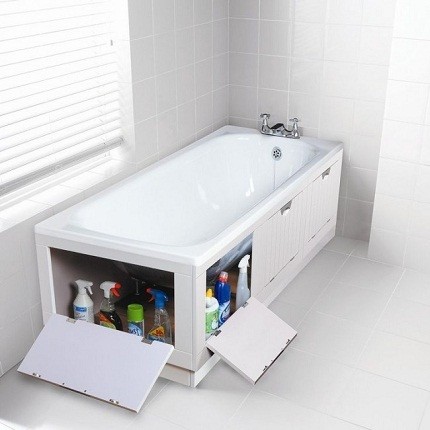
Doors can swing open not only to the left or to the right. There are models with folding elements. They have the same advantages and disadvantages as the swinging screens
Model selection: important nuances
First, decide on a design that is suitable for your purposes. The most convenient options:
- Blind stationary model with a technical opening without a door. This design is usually preferred by the craftsmen, who do everything themselves in the house. It is simple, convenient for access to pipes, but does not imply the arrangement of a mini-storage under the bathroom.
- Removable stationary model without a technical opening. If you choose a similar model, try to stay on such a panel, which can be easily removed if it is necessary to repair the pipes.
- Screen with swing doors. If the bath is spacious, then there will be no problems at all. If the area of the room is small, carefully calculate the dimensions of the doors so that they do not occupy the entire bathroom.
- Model with sliding doors. This is a universal screen that will be appropriate in any bathroom.
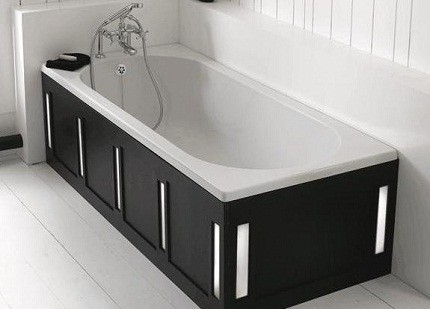
When choosing, you need to pay attention to the type, size, design design, type and performance of the material
Before buying, measure the space that you want to close. Standard screens have length 1.5, 1.6 or 1.7 m, width - 0.5, 0.55 or 0.6 m. There are also models of other standard sizes.
So, on sale it is possible to meet screens 1.05х0.5 or 1.9х0.5 m.
If you set a goal, you can find a model for any bath. The only difference is that among the screens of non-standard sizes there are fewer models of unofficial design or with a unique decor.
If you are satisfied with a design with a smooth monochrome surface, then this option can be found in any size.
Sometimes there are doubts about the required width. This happens when the screen is selected before finishing the finishing works in the bathroom.
Often the owner still does not know the exact dimensions, until the bath is installed and the tiles on the floor are laid.
The problem with selecting the model of the desired width is also relevant in cases where the floors of the room are biased. You can solve it by using a screen on adjustable legs.
When mounting, the feet are set to the desired height on each side.
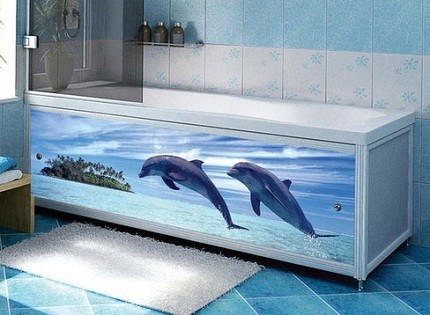
Models on adjustable legs need to be selected according to the length, because width can always be adjusted. Adjustable screens can be either monophonic or with a variety of ornaments
The best manufacturers of screens for baths
As for the producers, there are a lot of them, both domestic and foreign.
Among the Russian screens manufacturers, the trade marks Techno, Vann Bok (Karavann), Remstroyplast, Sear, Aquamate, Ecroline have well proven themselves. Their main advantage is universality.
Russian manufacturers take into account the diversity of the plumbing market and make models that are suitable for installation under the baths of different brands.
They offer a variety of design options, more than 30 shades of colors. Materials - the most diverse, including semi-soft panels of non-woven material.
A big plus of domestic bath screens is an affordable price. They are much cheaper than imported analogues of the same quality, but may be inferior in design and design.
Among foreign manufacturers it is possible to allocate the Italian trade marks Jacuzzi, Albatros, Finnish brand IDO and German Kaldewei.
All these companies produce high quality products, but often screens are only suitable for specific bath models.
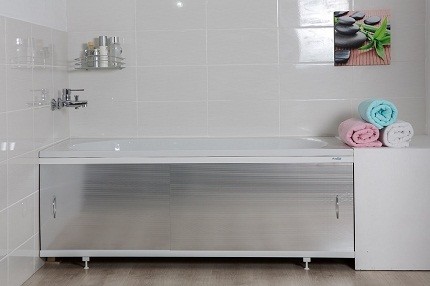
Sliding models of the "Professional" collection of the "Vann Bok" trade mark are made in black, white colors. There are screens of organic glass. They are equipped with beautiful handles of chrome-plated metal
Stages of installation of ready models
Ready-made screens for the bath are completed with frames, fittings and fasteners. All this should be indicated in the technical documentation for each particular model.
An installation manual should also be included. Before buying, make sure that everything you need is included.
If the dimensions are correct, then a minimum of tools will be needed for installation: roulette, construction level and screwdriver. Before starting work, it is recommended to fill the bath with water.
If the bath and the screen are installed simultaneously, this is not necessary.
The screens can differ in shape and design, but the scheme of their installation is always approximately the same:
- Measurements and marking. Before installing the frame, you need to again measure the niche under the bathroom and mark the place of attachment of the frame. If the panels do not fit a bit due to the curvature of the walls or floor, they are cut with a Bulgarian.
- Mounting the frame. The frame is mounted under the bath and fixed in accordance with the instructions, also install and align the guide Ш-shaped profile for the sliding models.
- Adjusting the legs. If the model is on adjustable legs, they are unscrewed so as to achieve maximum fixation of the frame between the floor and the side of the bath. To support more firmly held, and the screen did not tremble, when water is poured into the tub, you can put a little sealant under each foot and press it to the floor.
- Fastening the frame under the side of the bath. When the frame is firmly fixed, the space between the edge of the frame and the side of the bath is blown with a mounting foam. This will add extra rigidity to the structure.
- Installing the panels. Decorative panels are installed on the frame. If the doors are swinging, they are hung on hinges, the sliding ones are inserted into the guide profile. Screw the handles to the doors.
- Seam processing. Joints are desirable to be treated with a sealant. This will help protect the niche under the bathroom from moisture.
Installation of screens for acrylic baths has its own characteristics. Most often these baths are prefabricated with screens, suitable in shape and size. Models are usually made of plastic. The set includes a frame, panels, pens, brackets, dowels, screws.
![]()
The figures show the entire process of mounting the screen under acrylic bath. Installation of screens for baths made of other materials, has some differences. For example, in cast iron models it is impossible to drill holes at home, as there is a risk of chipping cast iron
If the bathtub is not equipped with a screen, it can be made independently from a wooden block and finished plastic panels. The frame is fastened to the side of the bath with liquid nails, the joints are additionally strengthened by cold welding.
To fix the lower brackets, drill holes in the floor and install dowels. After installing and adjusting the frame to fit the panels of the screen in the guides.
A sign that they are in their place is a characteristic click.
With the installation of decorative panels for the corner bath can be some difficulties. Sequence correct installation angular acrylic bath with the screen shown in the video:
Manufacture and installation of the screen by own hands
Many of our compatriots are used to doing everything in the house on their own. This can be considered a peculiar feature of the national mentality, as the desire to personally participate in the improvement of the home is associated with masculinity.
Such craftsmen can mount the screen under the bath with their own hands.
The video tells in detail how one can make a deaf screen with a technical niche. As the material of the panel, gypsum plasterboard is chosen, the finishing is the facing tile.
Assortment of screens for baths is huge. In such a variety it is very easy to get lost. If you have problems with choosing and installing the correct model, ask for advice from an experienced technician.
This is much more reliable than learning from your own mistakes.
As usual, in most cases, the bathrooms are small in size, and we want the baths as large as possible. And so many baths are installed between two walls. Well if the bathroom room allows you to install a locker for all sorts of cleaning and cleaning products, and all this stuff can be put there. But often we are deprived of such luxury and all this kindness goes to the storage just under the bath. The spectacle, of course, is not so hot. All this disgrace must be hidden. In the old days, our parents, under the side of the tub, pulled a wire or strong thread, and put on ordinary curtains like on windows. Thus, the contents of the inner space of the bath were closed. In our time, methods and materials, to close this space, have become more esthetic. And one of them is a plastic screen under the bathtub sliding.
Yes, only those methods of mounting such screens do not fit all types of baths. As often happens, that they bought, installed according to the instructions, like everything is beautiful under the iron bath. One or two times came, just pushed a foot and our screen fell out. Or, another example, a bath steel or acrylic, by weight themselves light. Installing under such baths the screen, we unscrew the legs on the spacer. But the rasp does not happen, because the baths are light, and we just raise them. That this does not happen, these screens need to be modified a little. Read on and you will learn how I do it.
First of all, the installation of the bath itself. I install it at 5-7 cm above the height of the screen. For example, if the height of the screen is 50 cm, then I install the bath from the bottom of the board to 55-57 cm. Then after installing the screen, a gap is formed between it and the floor. Through it nothing will be seen, and you can safely approach the bath in a dense.
Now the width. If you guessed right with the width, then you are lucky. But this happens very rarely. It is better to take it more broadly - you can always cut off excess, but you can not add it.
What usually consists of such screens. Two plastic guides (as in the old sideboards), strapped together by metal or also plastic tires. And between them plastic or dialed and glued together, from ordinary plastic panels, curtains with handles.
I will not torment you. I fasten these screens to the walls. To do this, you need a corner of 15 mm, preferably aluminum. Cut two pieces to the size of the guides. We mark in them and drill holes for dowels.
Then take out the curtains, measure the width between the walls, take away the thickness of the two corners, and according to this size. cut off the excess from the guides. In this case, you need to take into account where there will be tightening tires, and accordingly the legs.
If the guides with an aluminum insert, then we take our prepared corners and attach them with the help of metal screws. But if the plastic guides (they are hollow), you need to make the plugs, insert them inside and then fix the corners as well. Now the screen frame should fit tightly between the walls under the bathroom.
We collect water in the bath or put something heavy in it (carefully not to scratch it), insert the legs and set the frame in place, level the legs, twist the legs, and drill holes in the dowels.
Now we are adjusting the curtains. The face curtain should be approximately to the middle of the bathroom. Let's say, if the width under the bathroom is 124 cm, like in my photo, then the width of this curtain is 62 cm. And in the inner curtain should be 5 cm wider. We measure, mark a square and cut off the excess, a Bulgarian for metal. On the cropped end I dress the U-shaped plastic starting profile. I only wear it on the outer curtain, since the interior one is still not visible.
And yet, if you have pipes on top, then so that the curtains close tightly to the wall, we make cutouts in it.
When the silicone freezes, you can take out the load or drain the water from the bath.
So you found out how to install the screen under the bath. And the main thing is reliable.
Still sometimes I between a bathroom and the screen I insert a tile, plastic, external corner, having missed too silicone. Looks more beautiful. In this case, the screen is set taking into account the corner, slightly outward.
To cover the unsightly appearance of the bath, special screens are used. There are several types of screens for the bathroom, which differ in relation to the appearance and constructive features. On the ways of mounting the screen under the bath and how to make the screen under the bath, we will consider further.
Advantages and varieties of screen under the bathroom
The structural part, installed in the bathroom, which is able to close its appearance from the side and to the edges is called a protective screen. Thus, the installation of this element makes it possible to improve the presentability of the appearance of the bathroom, as quite often, under the bathroom there are communications that close the screen.
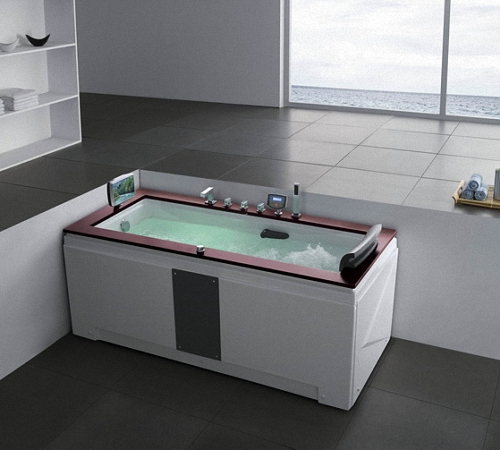
For the manufacture of protective screen use different materials in the form of plastic with various additives, aluminum and even glass. In addition, the screen will be retractable, sliding, standard, etc.
In relation to the design features, the screen under the bath is of two types:
- motionless;
- with the possibility of movement in a certain area of its functioning.
The first option is characterized by a lower cost, since it has a limited spectrum of action. After installing the screen, access to the reserved space is closed.
Screens mobile type are divided into several types. The movable screens have a door, with which they manage to access the space under the bathroom and some owners of such screens, even set up shelves for storing small things, are especially important in small bathrooms.
Screens of fixed type are less common, despite their cheap cost. This is due primarily to the fact that access to the space under the bathroom is always necessary. Since there are basic communications that connect the bath with sewage and cold and hot water. If it becomes necessary to repair or inspect this system, you must completely disassemble this screen.

The screen under the bathroom sliding consists of two panel parts, which are located in a frame, most often made of aluminum. In addition, this screen has legs on which it is installed and with which it is adjusted in relation to the height and the bath itself. With the help of the aluminum profile, the panels are moved along the surface. Thus, there is no problem with access to the communication system.
In addition, the installation of this type of screen allows you to hide behind the panels of all kinds of bathing products or cosmetics. Through the installation of a sliding screen under the bath, it is possible to provide an attractive appearance to any bath. Also, these screens come in different colors, shades, textures and patterns. It is possible to print any photo you like on the plastic. Plastic screens are capable of imitating wood, stone, glass, metal and any other textures.
The most common option for making the screen is plastic with a laminate coating. It is distinguished above all by excellent performance characteristics, resistance to moisture and mechanical damage. In proportion to the length, the standard screen size for the bathroom is 150 or 170 cm. In relation to the height of the screen under the bath, the dimensions are from 50 to 56 cm. In addition, to adjust the height of the screen under the bathroom, it installs special legs.
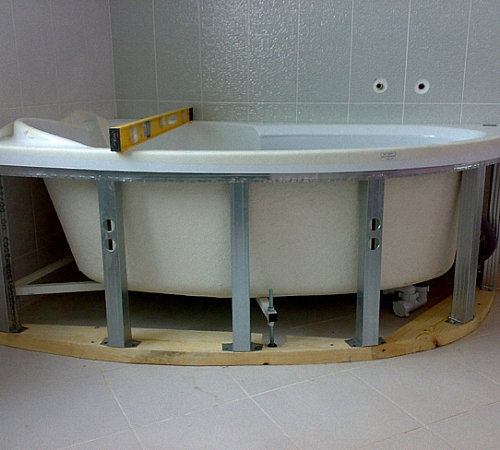
Depending on the design of the screens, they are divided into:
- the standard version of the screens - are plastic panels installed in an aluminum frame, their size corresponds to the strictly defined standards described above;
- screen of a universal type is also a plastic panel installed in an aluminum frame, however, such screens are adjustable in relation to their length, thus, even with sewer pipes, there are no difficulties with mounting this screen;
- screens with no end frames are less common, however, the appearance of such a screen is more presentable due to its integrity and lack of a frame;
- end screen - able to close only the end of the bath.
Screen under the bath photo:
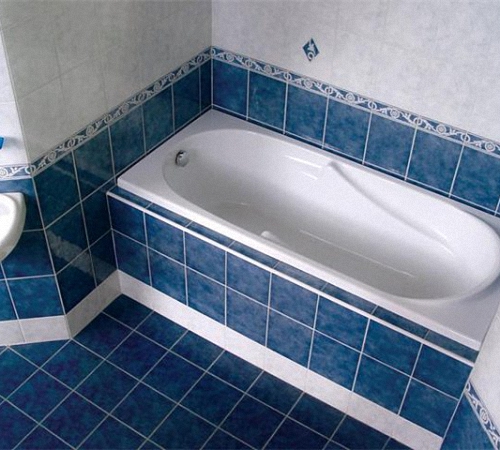
A variant of purchase or self-manufacturing of such a screen is possible, with certain skills of working with plastic.
In relation to the material from which the screen is made for a bath, they are divided into:
- plastic screen under the bath;
- metal screen;
- screen based on aluminum;
- glass models;
- screen under the bathroom of the tiles;
- screens made of MDF.
In addition, it is possible to combine two or more of the above materials in one screen. So, for a bathroom made in the style of hi-tech, you should choose a screen in which metal and glass are combined.

The main requirement for choosing a bathroom screen is a high level of its resistance to moisture. Since the bathroom is a room with a sufficiently high level of moisture and a constant presence of water.
We offer you to familiarize yourself with the advantages and disadvantages of each of the screens, in more detail:
1. Screens based on aluminum.
This version of the screens is very popular, among its advantages are noted:
- affordable price, in proportion to the screens made of glass and plastic, aluminum screens occupy the middle position on the price index;
- high strength characteristics, since aluminum is not susceptible to corrosion, has good operational characteristics;
- ease of weight allows you to simplify the process of mounting the screen;
- a variety of shades, which are selected in accordance with the appearance of the room.
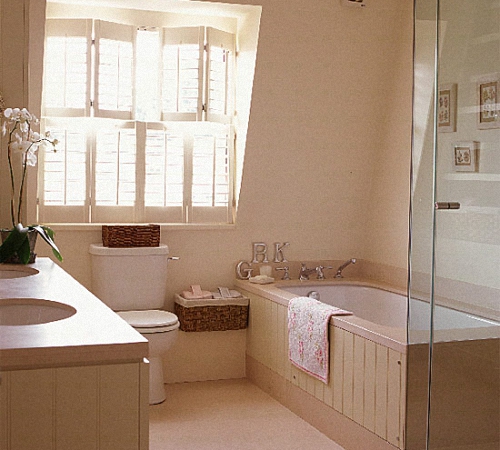
There are several variations of aluminum screens, which are manufactured in accordance with different parameters of the room. Aluminum corner screen under the bath, allows you to ensure its protection immediately from several sides. The screens consist of an aluminum frame, inside which are two plates based on plastic or glass.
These screen models allow you to select any color of the shutters. There is the possibility of not only two, but also several shutters. A variant of individual screen manufacturing is possible, in relation to the parameters of your bathroom.
2. Screens for a bath based on plastic.
Among the positive characteristics of screens based on plastic are:
- resistance to moisture;
- practicality and ease of care;
- durability and ease of installation;
- a variety of colors, patterns, textures, etc., plastic screens have the widest color range;
- the duration of operation, while the plastic screen practically does not change its appearance for 15-25 years;
- a variety of shapes, designs, colors, sizes;
- affordable cost - plastic models of screens are distinguished by the lowest cost, in comparison with glass or aluminum variants.
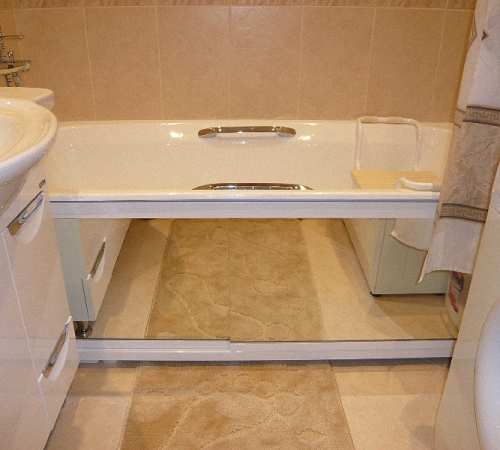
However, if you compare the price of plastic screens and models from MDF, then the first lose. Since the screen based on MDF is cheaper. A polyvinyl chloride profile is used to make the frame part of the screen, and in order to build panels - use plastic with a cellular structure, for the decoration of which a self-adhesive film is used, is capable of simulating even a tile.
3. Screen for a bath in the form of a mirror.
This version of the screens, in addition to being expensive enough, also differs in the complexity of installation. In addition, a screen made of a mirror, needs constant care for it with the use of special cleaning products. However, buyers for such models of screens are available. Since they can visually expand the space of the room and fill it with light.
4. Screen for a bath of MDF.
Among the advantages of this kind of screens, note:
- the lowest cost;
- since a laminated film is applied to the surface of the plates, they are distinguished by a variety of colors, shades and imitations of different textures;
- to ensure the care of the screen, it is enough to wipe it with a damp cloth;
- the possibility of buying a monolithic or sliding structure;
- the possibility of constructing a screen with your own hands.
However, such screens are distinguished by the presence of certain drawbacks:
- short life, which is less than three years, so the screen of MDF needs periodic replacement;
- the possibility of deformation, since MDF is unstable before moisture and when it comes into direct contact with it, the film is laminated and deformed;
- there is no possibility to adjust the screen, because they are manufactured strictly according to the standard.

How to make a screen under a bath with your own hands
The procedure for self-manufacturing the screen for a bath is as follows:
1. To make the frame part of the screen, you need to prepare a ceiling profile. To fix it, we use wooden blocks. Please note that they are installed in a vertical position relative to the bathtub.
2. After tightly pressing the bar against the floor surface, the profile is fixed using self-tapping screws.
3. The work on the fabrication of the frame is completed. Now the stage of the equipment of the screen follows. First, gluing plastic guides into the inside of the profile is done.
4. Next, you install the panel directly, which will perform the screen function. As a material for its production it is allowed to use plastic, plaster, glass, mirror, lining, etc.
5. In relation to the screen size, you need to cut out the panels from the above materials and mount them.
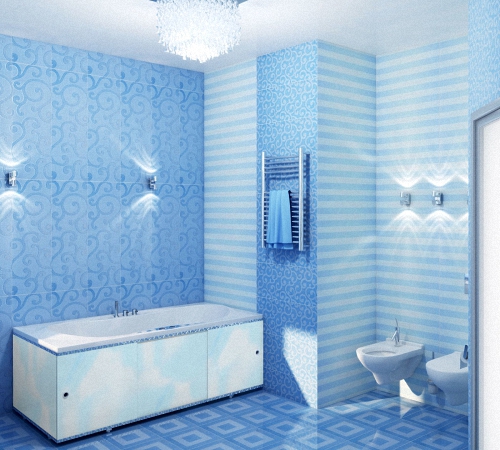
How to install a screen for a bath: technology work
We offer you to familiarize yourself with the main stages of installing a screen for a bath:
- using the level, mark the mounting locations for the fasteners to fix the screen;
- determine the measurements;
- using a metal profile, build a skeleton part;
- fix it in relation to the previously done markup;
- selecting the required material, depending on the screen size, cut out two, three or four panels;
- set them, check the level with the level.
Note that mounting the screen under the bathroom is a very serious process, especially if the bath is made of cast iron. In no case, do not try to drill holes in it, to fix the fasteners. It is possible to drill acrylic bathtubs, but not cast iron.
In relation to the complexity of the screen design, the level and time for performing the installation work is determined. If the design has a sliding form, then to open it, we recommend using special handles with suckers.
To mount the swing doors, proceed as follows:
- the first option implies independent manufacture doors using plastic inserts or profiles and fixing it with special loops;
- if further tiling of the screen is planned, the distance between the bathroom and the floor should be such that one or two tiles are placed in it completely, without scrapes.
In order for the screen to acquire additional strength and rigidity, it is recommended to use a mounting foam to blow out the space between it and the wall. Additional vertical racks help to improve the strength of the structure. For their manufacture use the same profile from which the frame was equipped.
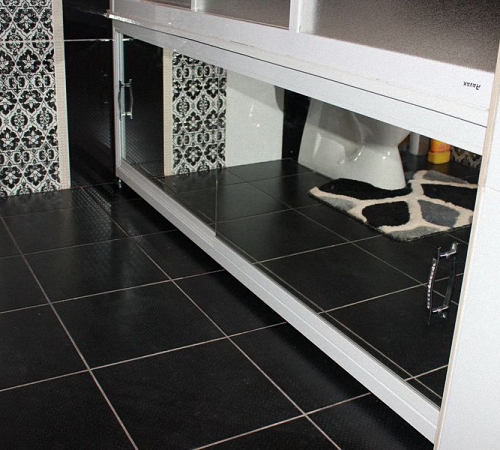
Installation instructions for the screen under the bathroom:
1. After buying the screen, you should make markings on the surface of the floor, the wall and the bathroom itself. The markup should display the location of the screen's fixation on the surface.
2. After the measurements have been completed, work should be carried out on the construction of the frame part. For this, wood or metal is used. It is preferable to use the latter option, since there is a risk of deformation of the tree, under the constant influence of moisture on it.
3. After the construction of the frame, the panels must be assembled, special mechanisms in the form of canopies or fasteners should be provided for fixing them.
4. Carrying out further work in each case individually and depends on the type of screen, its size and the features of the bath itself.
5. After fixing the panels on the surface, the screen is checked for operability, plastic shelves are installed, if any.
Screen for bath video:
Many consider the repair in the bathroom finished, when the tiles are laid out, the pipes, sanitary ware are replaced, and new accessories are put on the shelves. But the harmony of this picture can be violated by tap water or sewer pipes,. To correct this deficiency and to give the interior of the room a finished look will help. The tastefully selected screen under the bath not only disguises the plumbing, but also beautifies the exterior design of the room. You do not need to call a specialist to install the screen. Following the instructions, you can do all the work yourself.
Variants of screens for a bath
Bath screens can be classified by material and by design. Depending on the material from which screens are manufactured, among them one can distinguish:
- brick;
- plastic;
- gypsum plasterboard (with subsequent finishing);
- from moisture-resistant MDF, OSB;
- from thin metal, etc.
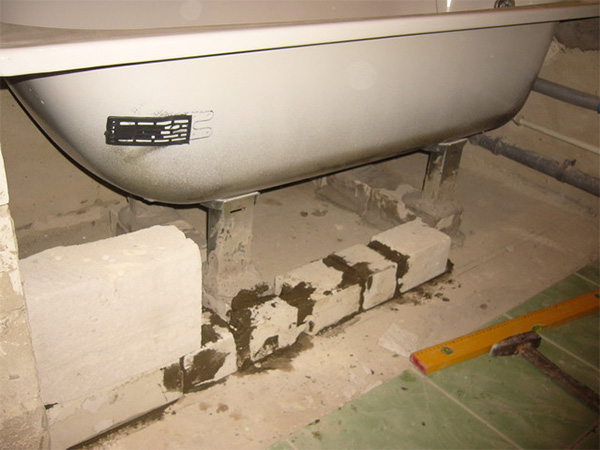
You can use bricks or foam blocks
Spread the screen made of bricks - the process is quite laborious. The main advantage of this screen is its reliability and durability. But there is a significant drawback. If there are problems with the pipes, requiring their repair or replacement, the brick screen will have to be broken.
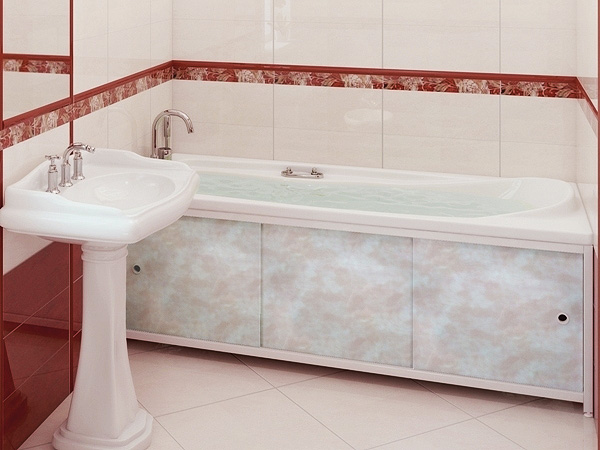
Plastic screen - cheap and practical
Plastic Bath screens are the most practical and affordable. They are not afraid of moisture, easy to clean, simple enough to install. The service life of such screens varies between 10-30 years.
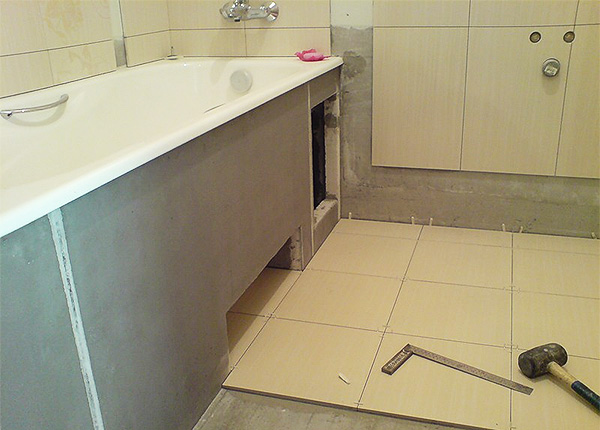
Screens from plasterboard absolutely ecological. They do not emit harmful substances and unpleasant odors. This material is considered "breathing", and does not disturb the microclimate in the room. Another significant "plus" is the ease of working with plasterboard. The main drawback is that access to communications located under the bathroom will be difficult.
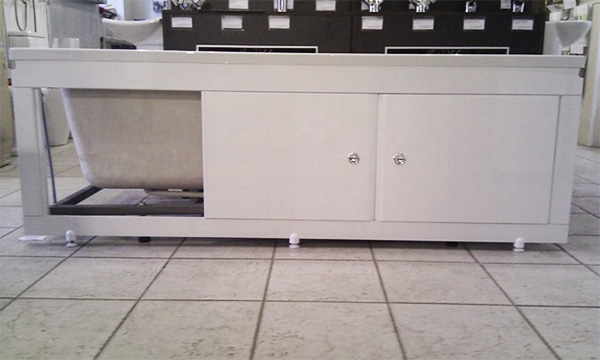
Screen from MDF
Screens from MDF are characterized by low cost and ease of care for them (it is enough to wipe such a screen with a damp napkin and it will shine with purity). Among the shortcomings is a short construction life (about 3 years) and susceptibility to deformation (despite the laminated surface).
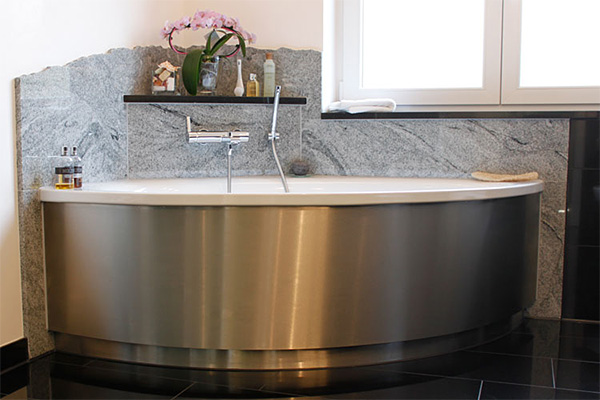
Metal screen
Metal screens are durable. They have a reliable design, do not deform and do not lose their original appearance.
By design features screens are divided into:
- the deaf;
- with sliding doors;
- with swing doors;
- removable;
- with retractable block, etc.
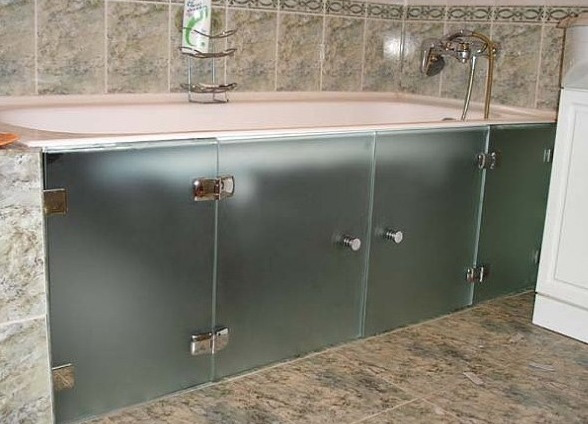
Regardless of the material selected, the bath screen must meet the following basic requirements:
- It should not be a load-bearing structure, i.e. the bath should not rest on it.
- It is necessary to provide a technological opening (it can be masked with a door or a plug) for access to communications.
- The space near the floor, separating the floor under the bathroom from the rest of its part is preferably sealed.
The order of installation of the screen under a bath
Regardless of the material selected for the manufacture of the screen, its installation should be carried out in the following sequence:
- First mark the place of fixing the screen on the floor and walls (this is done using a level). Then lines are drawn along which the screen will be installed (taking into account the correction for the thickness of the overall finish);
- The necessary measurements are made;
- From a metal profile or a wooden beam a skeleton under a bath is made (for the brick screen the skeleton is not required);
- Next, the frame elements are fastened in accordance with the marked markings;
- The panels of the corresponding sizes are cut from the selected material;
- Then these panels are fixed on the frame;
- If necessary, facing works are done.
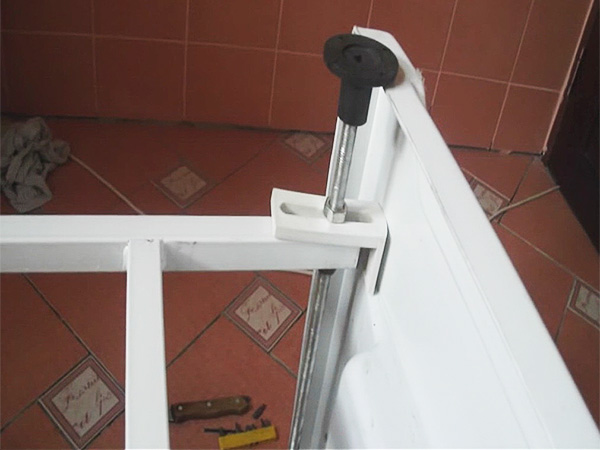
If the screen is installed under the acrylic bath, the fasteners can be mounted directly on its sides. With a cast-iron bath, this should not be done in any case! Otherwise, the bath enamel will be spoiled.

The more complex the chosen screen design is, the more laborious it will be to install it. For example, for a screen with sliding doors, it is necessary to mount the guide and S-shaped profile from above and below. Next, two panels are cut out - future sliding doors. In this case, the length of one of them should be somewhat larger than the other (it is necessary that the panels overlap each other). After that, the panels are inserted into the guide profile, and the handles are attached to them.
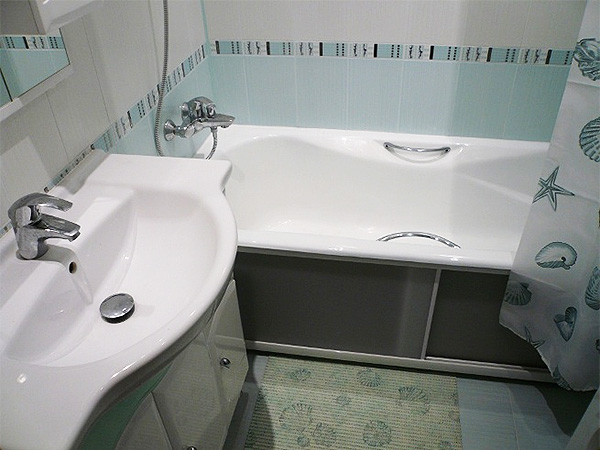
Sliding design facilitates access to the drain
To impart additional rigidity to the screen, the space between the upper frame element and the side of the bath is filled with a mounting foam. It is not superfluous to find a sealant here. The frame can be strengthened with additional vertical racks.

The screen can be tiled in the tone of the entire room
If a wooden beam is used to create the frame, it is recommended to pre-treat it with soil with an antiseptic and a special agent that protects against moisture. Otherwise, the tree will start to rot or a fungus will appear.

Homemade bath screen with sliding door
On whatever version of the screen you are not stopped, its self-installation It takes a little longer than installing a ready-made purchase screen. But this design will be more economical and reliable than most screens presented in stores. Yes, and the design of the design can be selected to your taste and as much as possible suitable for the general interior of the bathroom.

